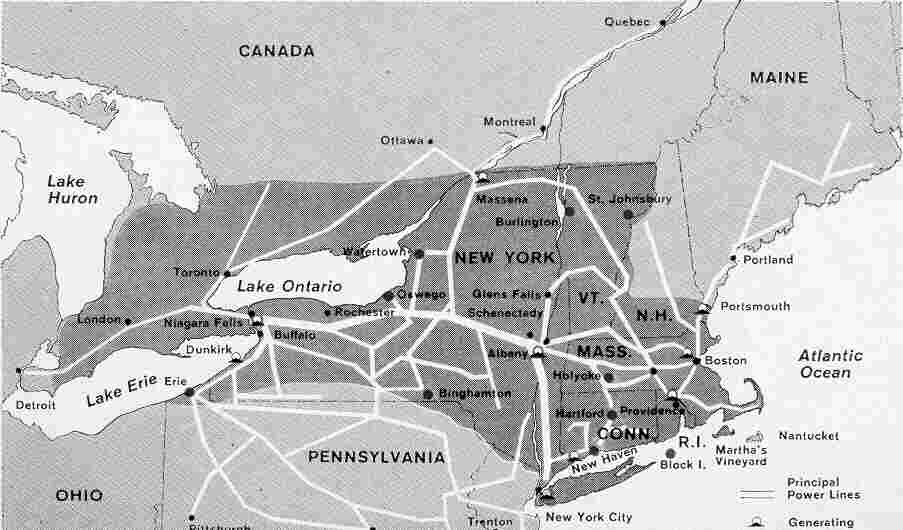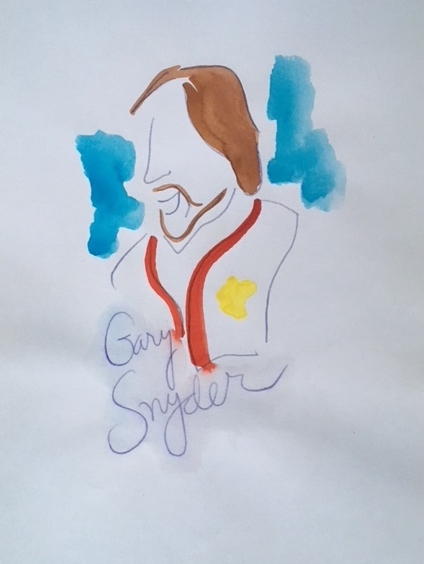We turn the clocks back at this time of year and never fail to be surprised by the early darkness no matter how old we are. The sun went down around 4.30 p.m. in Amesbury, Mass. The Halloween decorations will stay up for another week or so. Walking Ringo-the-dog this evening, Rosemary noticed an undecorated Christmas tree in the front room of a house down the street. People my age and older remember another November when the lights went out all over northeastern America. I’ve been writing a memory book for the past year and recalled what happened as best that I could, helped a bit by some newspaper research. I’m posting the short chapter here and on Facebook. If readers want to share their experience of the Blackout, please add comments.—PM
Great Northeast Blackout Map (web photo courtesy of LIFE magazine, 1965)
New York Times front page, November 10, 1965 (web photo courtesy of NYT)
The Great Northeast Blackout
On NOVEMBER 9, 1965, WHEN THE LIGHTS WENT OUT FROM LAKE ONTARIO east to Boston and south to New York City, sinking thirty million people at home or work into darkness, my family was ready to sit down for supper at the kitchen table at twenty-eight minutes past five o’clock. Tomato sausages sizzled in the fry pan. Potatoes and green peas heated on the rear stove ringers. My older brother Richard wasn’t home from his art-teaching job in Acton, and second-older brother David was in the cellar noodling on his guitar, trying to find the chords for “Honeycomb” by Jimmie Rogers, the 1957 hit song that David cued up again and again on the portable turntable. In my bedroom, I had a good battle in progress with plastic blue-coats and gray-coats set up for another Civil War engagement on the hardwood floor.
This was a Tuesday, so Mum was not working her evening shift at the clothing store downtown. She always said, “Tuesday is a good day.” I don’t know why, exactly, but she believed St. Anthony paid special attention to Tuesday happenings. Halloween was over, and the clocks had been turned back, so it was dark out early. We had lights and lamps on throughout the house—and then we didn’t. The stove and refrigerator quit. The TV in the living, which had been left on, blinked off. David had to feel his way up the cellar stairs. My parents said, “What’s going on?” Power outages were nothing new. Thunderstorms knock out transformers and a blizzard can bring down tree limbs that crash electrical lines. But the weather wasn’t violent.
Houses across the street and behind us were dark. Everyone had been hit by whatever happened. My father dug out a silver flashlight from the junk drawer near the kitchen sink. He got a second one in the hall closet. Mum pulled candles and holders from the cabinet above the fridge and lit them with matches. I set my pocket transistor radio on the kitchen counter and tuned it to the main Boston AM station, WBZ, to get news. Immediately, reporters described a widespread event.
Mum took the pans off the stove and packed the food in containers. The refrigerator was still cold. We ate ham-and-cheese sandwiches with yellow mustard and dill pickles on the side with milk to drink. Richard drove up the driveway about six o’clock, saying the traffic was slow because signal lights weren’t functioning. All the buildings were dark except for a few battery-run emergency lights and some run by gasoline generators. We put sweaters on when the house cooled down after about ninety minutes. Around seven o’clock, Nicky Beaumont who lived next door ran up and down the street blowing a long plastic noisemaker horn that he had bought at a football game, announcing nothing but his own boredom. Richard read the newspaper by candlelight. Mum went to her bedroom to lie down. Dad, David, and I played cards, Hearts, at the kitchen table with candles in the middle.
“Striking at the evening rush hour,” the New York Times reported, “the power failure trapped 800,000 riders on New York City’s subways. Railroads halted. Traffic was jammed. Airplanes found themselves circling, unable to land.”
The power clicked on about midnight. Dad heard the oil burner re-start. Some parts of New York didn’t recover electrical power until daybreak on Wednesday. The morning newscasters on TV told us that a safety relay failed at Sir Adam Beck Hydroelectric Power Station No. 2 in Queenston, Ontario, on the Canada side of Niagara Falls. Electrical demand had spiked at the supper hour on an extra-cold night. Overwhelmed by the demand, one relay switch shut down to protect the rest of the system. Like water stopped at a dammed brook, the juice diverted to other electrical tributaries which in turn detected an overload and tripped—the whole problem cascading eastward, overwhelming those stations and most of the northeast power grid. One plant at Niagara Falls remained online to service Buffalo.
Eighty million square miles over two countries went black, cold, and quiet. Government and utility company officials snapped to action following the massive breakdown, aware that a serious infrastructure weakness had been exposed accidentally, which revealed a national security vulnerability. This kind of system failure had a Third-World quality and was not expected in a country sending astronauts into orbit around Earth. The authorities had called out some 10,000 National Guard troops to keep order and prevent looting in the big cities. Fortunately, the dark hours passed without a crime wave.
Everyone at my house returned to the weekday routine on Wednesday. The Blackout was the talk of the school bus and school yard before the morning bell. Twelve years later, another major power failure in New York City resulted in extensive damage on the streets when looters and other petty criminals made trouble in the dark. In 2003, a third extensive blackout hit the Eastern U.S. and Canada’s Atlantic provinces. There would be more hurricanes and nor’easters to knock out power for hours or days in coming years, but the Great Northeast Blackout hung in the mind’s attic as a warning that the machines we cannot see will break again some future night.
from Blue Suburban Sky by Paul Marion, a memory-book-in-progress (c) 2019





























